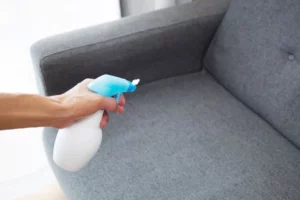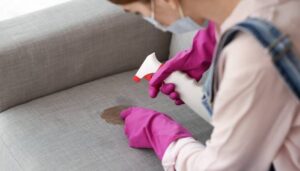Cleaning a leather sofa may seem like a chore, but if you do it right, it can be easy and even fun. Because leather is made from natural materials, it needs extra care to look its best. But in the end, you have a piece of furniture that looks better and better over time. Here are some simple ways to clean and care for your leather sofa so that it remains a beloved part of your home for years to come.
Understanding Leather:
Before you start cleaning your sofa, it is also important to know what your sofa is made of. There are two main types of leather sofas: protected leather (also called ‘finished’) and unprotected leather (also called ‘unfinished’). Unprotected leather is more susceptible to damage because the surface does not have a coating that extends its life and prevents stains. The protected leather surface is coated. Knowing what type of leather your sofa is made of can help you decide how to clean and care for it.
Regular Maintenance:
- Regular dusting and vacuuming: First, use a soft cloth to dust every day. Then use the soft brush attachment of your vacuum cleaner to clean crevices and surfaces. This prevents dirt from building up and makes it easier to perform a deeper cleaning.
- Quick Leak Treatment: If any leakage occurs, wipe it immediately with a clean, dry cloth. Do not wipe up spills as this will make the situation worse. If there are oil or grease stains, sprinkle some baking soda on it and let it sit for a few hours. Then dust them lightly.
Cleaning:
- Test Cleaning Products: Before using a cleaning product on your entire couch, test it on a small, hidden spot first. To ensure you don’t damage the leather or change its color, wait until the test area has dried.
- Make your cleaning solution: Mix equal parts white vinegar and water to make a mild cleaner. Wipe the leather surface with a soft cloth moistened with the solution and wrung out. This method is especially effective on leather that has been protected.
- Commercial leather cleaner: If you want to remove tougher stains or clean untreated leather, you may be able to use a commercial leather cleaner. Carefully follow the instructions provided with the product.
- Moisturizing soap: As a gentle cleanser, you can use Dove or another moisturizing soap. Wet the cloth, apply soap, and gently wipe the surface of the sofa. Rinse the cloth, squeeze out as much water as possible, and wipe away the soap.
Conditioning:
- Leather conditioner: Applying leather conditioner after cleaning your leather will keep it supple and prevent cracking. Use a conditioner suitable for the type of leather on your sofa and follow the instructions.
- Remove ink stains with alcohol: To remove ink stains, use a cotton swab dipped in alcohol and wipe it gently. Do not rub as this will spread the ink. Add leather conditioner on top.
- Avoid direct sunlight: To prevent your sofa from fading and drying out, avoid direct sunlight and heat sources. Regular conditioning can also counteract the effects of light and heat.
Preventative Measures:
- Use Throws and Pillows: Throws and cushions can protect your leather sofa from body oils and possible stains. You can use them to protect your sofa and make it look better.
- Avoid using sharp objects: Be careful with buckles, shoes, and pet paws as they can scratch or puncture the leather. Trim your pet’s nails regularly and pay attention to things that fall on the couch.
- Professional Cleaning: If your sofa is really dirty or needs a deep cleaning, you may want to hire a professional leather cleaner. They know how to safely clean and repair your sofa and have the right tools to do so.
Remove Stubborn Stains:
- Grease Stains: As mentioned earlier, baking soda can help remove grease stains. For stains that cannot be removed, you may need to hire a professional cleaner.
- Water Damage: It is important to clean up any water spills immediately. If water spots appear, gently wipe them away with a damp cloth and allow the area to dry on its own. Conditioning the leather afterward can restore its texture.
- Mildew: Leather can develop mold or mildew in damp areas. Equal parts water and rubbing alcohol should be mixed and used to clean the area. Allow to dry completely after cleaning.
Conclusion
Caring for your leather sofa means regular maintenance, promptly cleaning up spills, and occasional deep cleaning and maintenance. If you know what your leather needs and clean up spills and stains promptly, your leather sofa can look great for years to come. It’s important to remember that how you treat your leather sofa every day is just as important as how you clean it. If you follow these simple tips, your leather sofa will become a stylish, comfortable, and durable part of your home.
FAQs
1. How often should I clean my leather sofa?
Once a week you should dust and vacuum your house. Every three to six months, depending on the frequency of use and the amount of dirt and oil it has been exposed to a deeper cleaning can be carried out with a suitable cleaning agent.
2. Which cleaning product can I use for my leather sofa?
No, do not use harsh chemicals or household cleaners that are not specifically designed for leather. These things can damage the leather surface. Always use a leather cleaner or a mild mixture you can make at home, such as water and white vinegar.
3. How do I know if my leather sofa is protected?
Protected leather is easier to clean and has a smoother, shinier surface. Unsealed leather feels softer and absorbs liquid faster. If you are unsure, check the manufacturer’s information or place the water in a small, hidden area. If it contains beads, it is probably safe.
4. What should I do immediately after a leak?
Wipe up spills immediately with a clean, dry cloth. Do not rub as this will spread the liquid. If oil has been spilled, sprinkle baking soda over it to absorb the oil. Brush off gently after a few hours.
5. Can I clean leather sofas with water?
You can use diluted water, especially mixed with white vinegar, to make your cleaning solution. But never use a wet cloth on leather; always use steam instead. Wet leather can damage it.
6. How do I remove ink from leather?
Take a cotton swab dipped in rubbing alcohol and gently rub the stain. Do not rub the stains. Then use a leather conditioner to prevent dryness.


